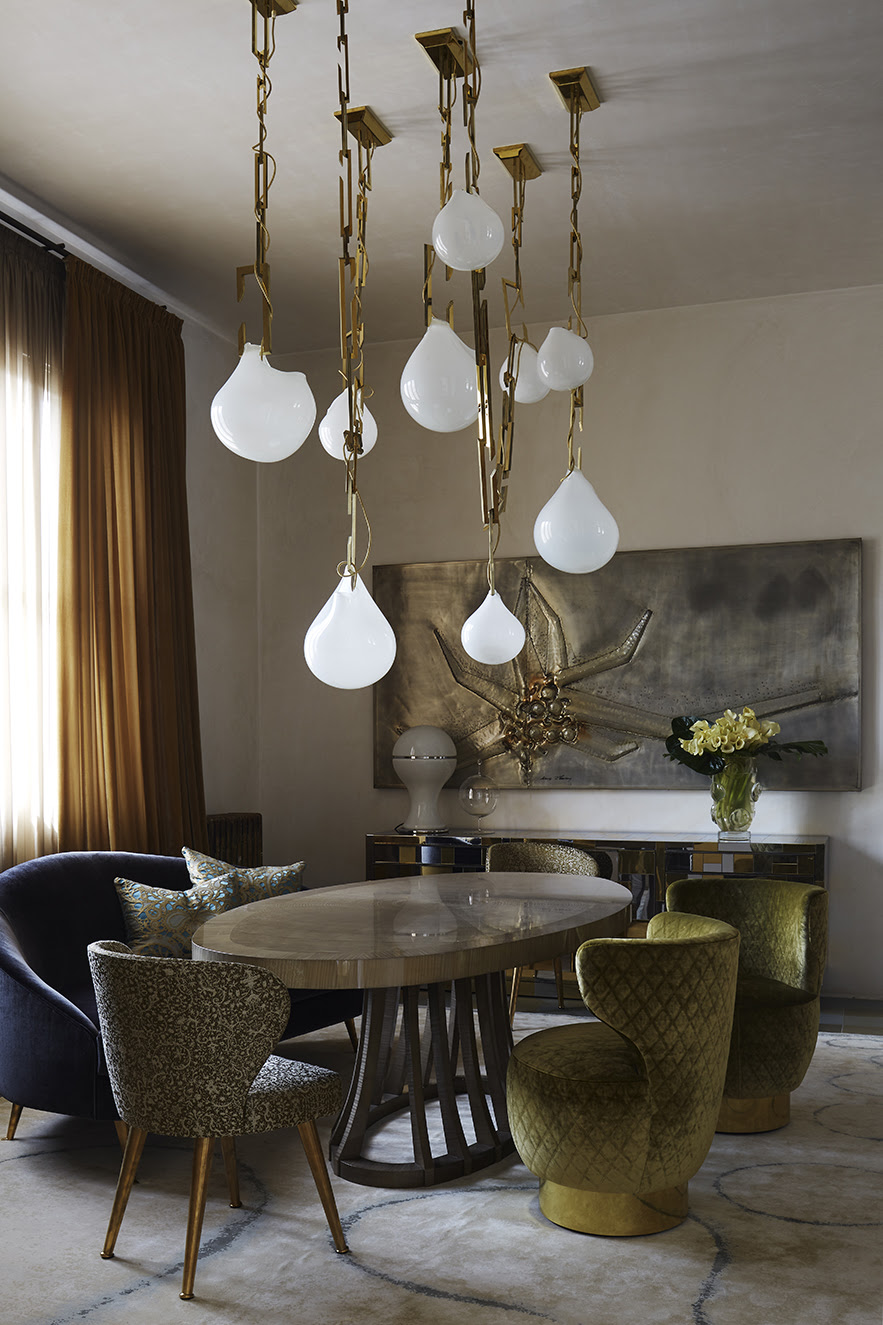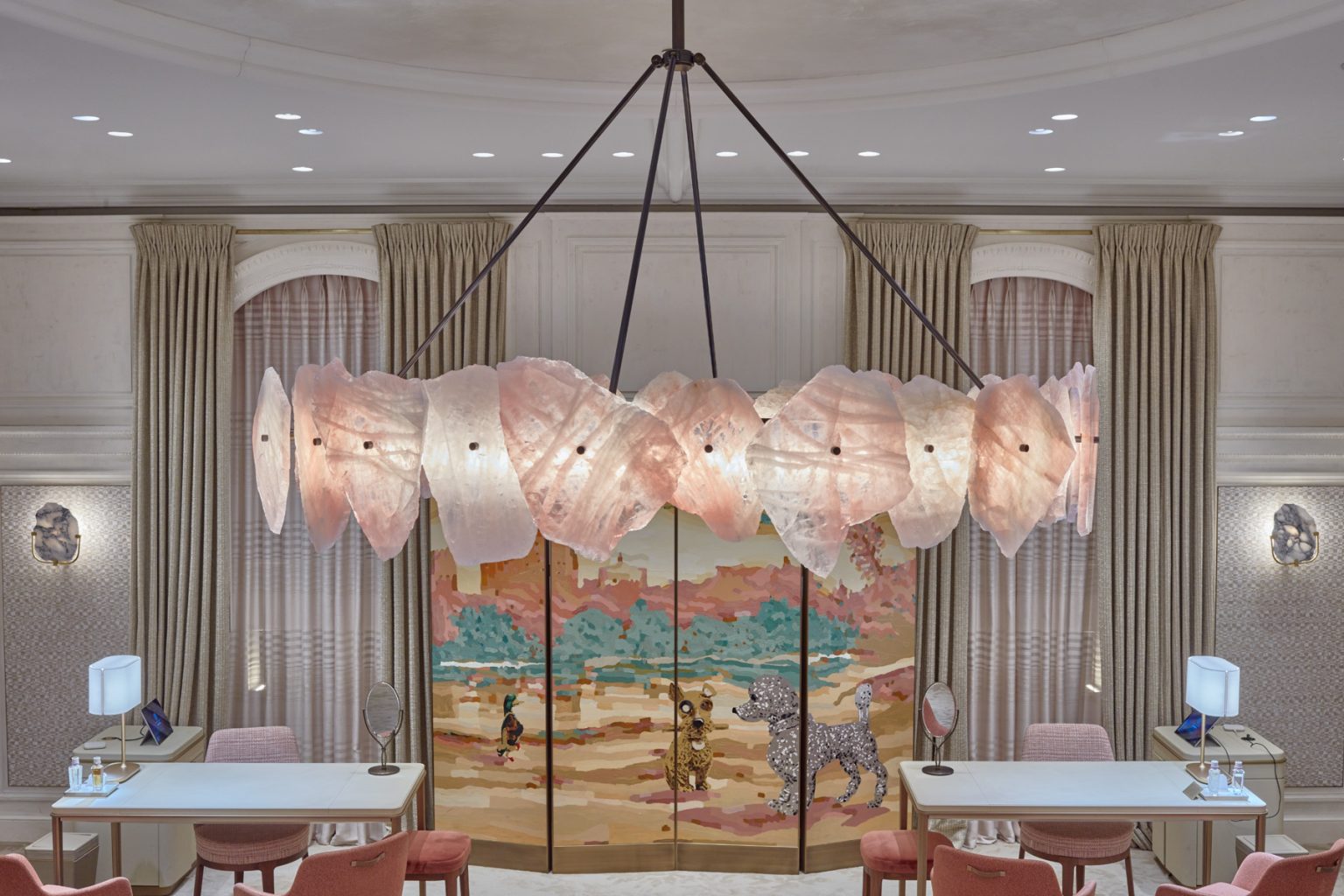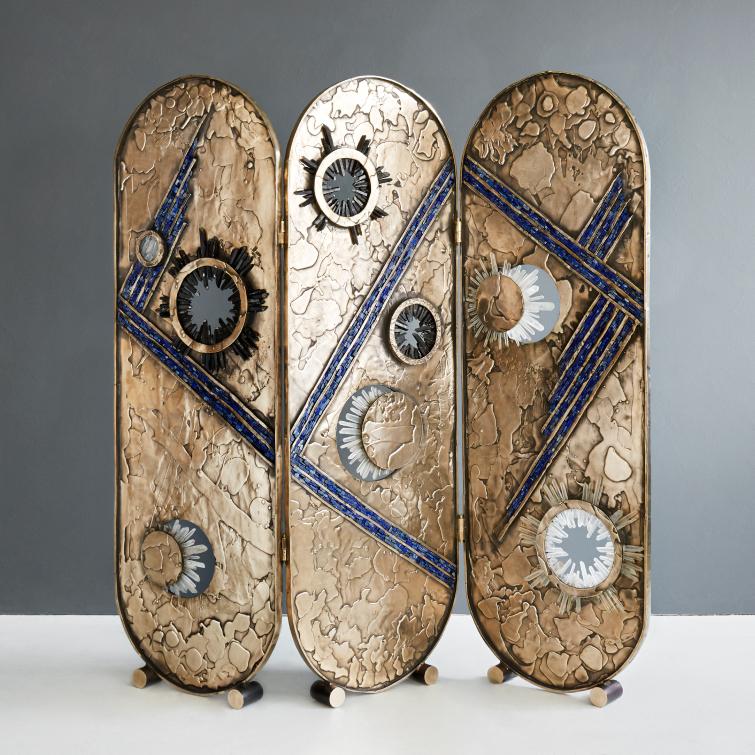Often Shining with Quartz Crystal, Christopher Boots’s Work has a Timeless, Elemental Feel

BY IAN PHILLIPS
The designer mixed classical and contemporary when crafting the apartment for a family of four.

Australian maker CHRISTOPHER BOOTS, seen here in his Melbourne-area studio, creates minimalist lighting that’s frequently inspired by Greek myths (photo by John Tsiavis). Top: His PROMETHEUS I and II chandeliers are made of brass rings set with QUARTZ crystals (photo courtesy of Christopher Boots).
Lighting designer CHRISTOPHER BOOTS is a little embarrassed to admit it, but he doesn’t have overhead lighting in his bedroom. “I could have had a great CHANDELIER, but the joiners covered the ceiling with Baltic pine, and we couldn’t really drill through it to poke around for the cables,” he says. So, he makes do with candles and plug-in lamps.
Since setting up his Melbourne studio, more than 12 years ago, Boots has firmly established himself as one of Australia’s leading lights, so to speak, in design. He has received commissions from HERMÈS, CASSINA and Milan’s GALLERIA ROSSANA ORLANDI and has placed three chandeliers in CARTIER’s Sydney flagship store, including an installation for the stairwell made from clear crystal QUARTZ and sand-cast bronze with forms inspired by coral and stalactites. The lobby of the Ritz-Carlton, Melbourne, displays his Phasmida pendant lights, and one of the suites at the legendary Badrutt’s Palace hotel in St. Moritz is graced by his PROMETHEUS CHANDELIER.
Los Angeles–based interior designer OHARA DAVIES-GAETANO recently chose a Boots Nepenthes ceiling fixture for a house in Laguna Beach. “Christopher’s work is very expressive and evokes a magical emotional resonance due to its materiality,” she notes. “The combination of crystals, blown glass and metal melded into poetic forms elicits a sense of wonder.”
The combination of crystals, blown glass and metal melded into poetic forms elicits a sense of wonder
The names of many of Boots’s creations hark back to Greek mythology. According to his website, Nepenthes is “a magical substance that quells all sorrows”; the chandelier named for it consists of chains — some vertical, others parabolic — hung with bulbous, milky spheres. Prometheus, named for the Titan who gave fire to humankind, consists of a large brass ring to which dozens of small quartz crystals are affixed so that it resembles a circle of flame when lit. The ceiling lights and sconce in the Ouranos collection incorporate perfect quartz spheres (Ouranos is the mythological personification of the sky).

Several of the designer’s Nepenthes pendants adorn a home in South Yarra, Australia. Photo by Christine Francis
Boots’s love of ancient Greece no doubt has something to do with his heritage. His maternal grandparents were of Greek origin, and he lived in the country for a couple of years during his childhood. At around the age of seven, he received a book on mythology, which he still owns. “I loved that stuff — I ate it all up,” he says. Another early passion was natural stones. He still remembers finding a crystal on a beach as a child in the mid-’80s. “I was like, ‘Wow! What is this thing?’ I got totally entranced by the whole world of rocks.”
That enchantment has developed into a particular love of quartz crystal — the material Boots uses most in his work. He has said that it represents “the beauty of geological time,” and during a Zoom interview, he goes to a corner of his office to pick up two huge chunks. “They’re incredible,” he says. “The transmission of light is amazing.”


A stairway in CARTIER‘s Sydney flagship store winds around a dramatic grouping of Boots’s Stalactite pendants. Photos by Nic Gossage
Boots explains that he specialized in lighting because of the way it affects our experience of space. “My pieces should be making you feel soft, ambient, like you could be in a drama or a mystery or an intrigue,” he says. “That’s what we’re missing in this world.” He created his first illuminated piece at the age of 10, when he collected sea urchin shells and glued them to the Christmas lights. By 15, he was making lamps from computer chips, cast concrete and X-rays; for his 18th birthday, he received a welder, with which he fashioned chairs and tables from discarded rebar.

Made with slices of pink quartz, a Petra pendant enhances the rosy decor in a room at the Cartier mansion on New York’s Fifth Avenue. Photo by the Behrens
He went on to study design at the Swinburne University of Technology and, upon graduation, joined the studio of local iconoclastic lighting designer Geoffrey Mance. Mance “experimented with unexpected and thought-provoking materials and processes,” Boots recalls. “He taught me to lean into experimentation and not be limited by fear.”
He taught me to lean into experimentation and
not be limited by fear
After Mance’s death, in 2007, Boots stayed at the studio for four more years before launching his own firm. Initially, he worked out of a 500-square-foot space with just a friend to help him. Today, his headquarters is in a 1940s 15,000-square-foot former printing shop in Melbourne’s Fitzroy district, where he oversees a team of roughly 35.


Boots hand assembles an Ouranos chandelier, composed of quartz-crystal spheres suspended in a brass fixture. Photos by Matt McQuiggan
In conversation, Boots is wonderfully animated and voluble. On his desk sits a vintage TABLE LAMP manufactured by the Italian firm BILUMEN, and on the shelves behind it is a book on VIENNA SECESSION architect ADOLF LOOS. Also in his office are a bust of Hermès, a table covered with rock and crystal samples and a shelf laden with CERAMICS, including a mug by Los Angeles–based sculptor Ben Medansky and a pitcher Boots picked up at a Paris flea market. The majority of his production is carried out by hand in the adjacent workshops, although he collaborates with a neighboring foundry for metalwork.
Boots often compares his lighting creations to GEMS. “I’m basically doing jewelry on a larger scale,” he says. He tends to keep his designs simple. “I try to be as reductive and purist as possible, because in my world, you need to honor the material,” he explains. He generally sticks to elementary geometric forms, whether circles, prisms or straight lines, with the only irregularities those introduced by the addition of his beloved quartz crystals.


In addition to lighting, Boots has made a few exceptional and intricate pieces of furniture, including his Curiosity cabinet, left, and Vanity screen, right. Photos, from left, by Guy Lavoipierre and Christine Francis
He is currently busy exploring different types of glass. “Ultimately, I’d love to be able to cast our own out of the refuse from the local area,” he says. He is also thinking of branching out more into furniture design. To date, he has created only a couple of highly crafted pieces — his stunning Curiosity cabinet, encrusted with LAPIS LAZULI, and his Vanity screen, which took him four years to complete and features a moon-like surface cast in solid bronze.
More than anything, Boots’s goal is to make objects that last. “What’s the point of making landfill when you can make heirlooms?” he asks. He sometimes plays with the idea that his designs may be sold at Christie’s in 2200 and, when asked which will best stand the test of time, names the Diamond ring chandelier, consisting solely of a circle of sparkling quartz crystals. “It’s so simple that it will never date,” he says. “It’s something that would look as good in a neolithic setting as it would in a space station.”





